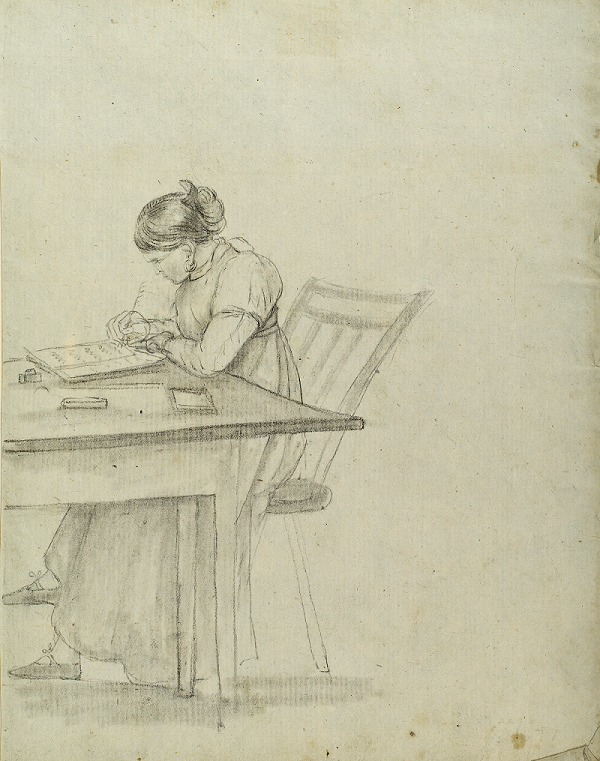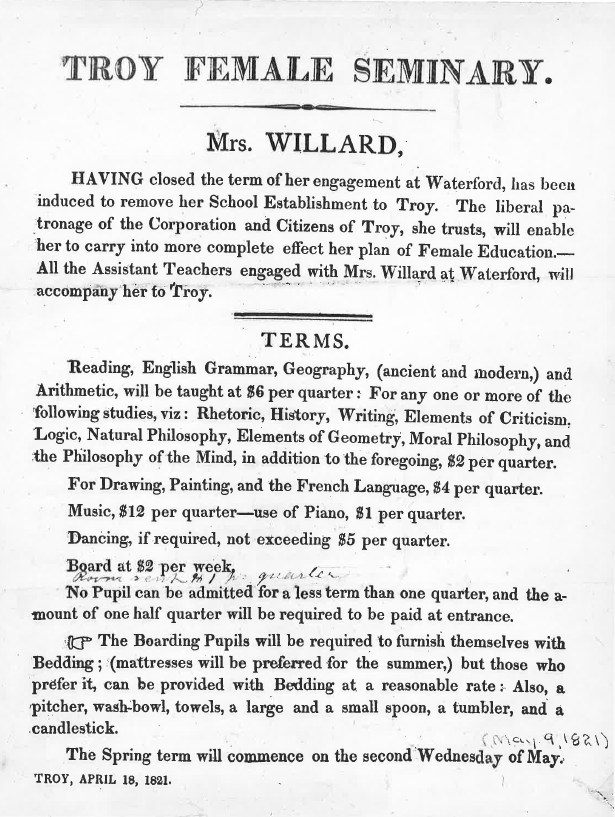Document Text |
Summary |
| Troy Female Seminary.
Mrs. Willard, |
Troy Female Seminary.
Mrs. Willard is moving her school to Troy, New York. She hopes that the city and people of Troy will financially support her plan for improving female educational opportunities. All of her teachers are moving to Troy with her. |
| Terms. Reading, English, Grammar, Geography, (ancient and modern,) and Arithmetic, will be taught at $6 per quarter: For any one or more of the following studies, viz: Rhetoric, History, Writings, Elements of Criticism, Logic, Natural Philosophy, Elements of Geometry, Moral Philosophy, and the Philosophy of the Mind, in addition to the foregoing, $2 per quarter. |
Pricing and Requirements For $6 a quarter, students can learn reading, English, grammar, geography, and math. For an additional $2, students can choose to study public speaking, history, writing, debate, logic, science, geometry, ethics, or philosophy. |
| For Drawing, Painting, and the French Language, $4 per quarter. Music, $12 per quarter—use of Piano, $1 per quarter. Dancing, if required, not exceeding $5 per quarter. Board at $2 per week. |
It costs $4 a quarter to study drawing, painting, and French. It costs $12 a quarter to study music, plus $1 to rent a piano. Dancing will not cost more than $5 a quarter. It costs $2 a quarter to live on campus. |
| No Pupil can be admitted for a less term than one quarter, and the amount of one half quarter will be required to be paid at entrance. | Students must sign up for at least one quarter and pay half their entry fee to start classes. |
| The Boarding Pupils will be required to furnish themselves with Bedding; (mattresses will be preferred for the summer,) but those who prefer it, can be provided with Bedding at a reasonable rate: Also, a pitcher, wash-bowl, towels, a large and small spoon, a tumbler, and a candlestick. |
Students who live on campus must bring their own bedding, water pitcher, wash bowl, towels, spoons, cup, and candlestick. Bedding can be rented for a small fee. |
| The Spring term will commence on the second Wednesday of May. Troy, April 18, 1821. |
The spring term begins on the second Wednesday in May. |
Catalog, 1821. Courtesy of the Emma Willard School.
Background
In the Federal period, Republican Motherhood was the ideal for white women. Republican mothers were responsible for raising the boys who would someday vote in U.S. elections. Writers and theorists called for improvements in women’s education so that they would be better prepared for this important responsibility. In response, new schools for girls were founded. In these schools, girls learned more than how to manage a household and basic literacy that characterized girls’ education in the colonial era. By the end of the Federal period, these new educational opportunities would lead some women to wonder why they couldn’t become voting citizens.
About the Image
These resources illustrate what girls’ education looked like in the Federal period. Female Student Writing shows a young woman studying at the Economical School in New York City. This school was founded by Baroness Hyde de Neuville in 1810. It provided free or low-cost education for the children of white refugees of the Haitian Revolution. The school taught academic subjects and job training so that graduates could have the skills they needed to get a job when they graduated.
The Troy Female Seminary was the first all-girls secondary school in the United States. It was founded by Emma Hart Willard, who wanted to give young women the chance to study subjects that were traditionally reserved for boys. A full year’s basic tuition cost $18, or about two months earnings for a working-class person. This made the school cost-prohibitive for most American women. The catalog includes details about what students could study. Today, the Troy Female Seminary is known as the Emma Willard School. It is still considered one of the best private schools for girls in the United States.
Vocabulary
- Federal period: The early years of the United States, usually defined as 1790–1830.
- Haitian Revolution: The successful rebellion of enslaved Black people against their French enslavers in the French colony of Saint Domingue. The uprising began in 1791 and ended with the formation of Haiti as an independent country in 1804.
- Republican Motherhood: A term historians use to describe the responsibilities and expectations placed on women in the Federal period.
- seminary: A college that prepares students to be priests, ministers, or rabbis.
Discussion Questions
- What do these sources reveal about education for women in the Federal period?
- Was the education at the Troy Female Seminary widely available to all women? Why or why not?
- Why did the education for refugee children include vocational studies? What does that tell us about some of the differences between these schools and their pupils?
Suggested Activities
- Ask students to pick out their ideal course of study at the Troy Female Seminary and determine the cost for one semester. Discuss what these prices tell us about the women who attended the school.
- Ask students to compare this course of study with the speech on Republican Motherhood. Does an education at the Troy Female Seminary prepare a woman for a life as a Republican mother? Why or why not?
- For a larger lesson about women’s education in the Federal period, teach these sources together with: Life Story: Almira Hart Lincoln Phelps and Propagating “American” Womanhood.
Themes
AMERICAN CULTURE








